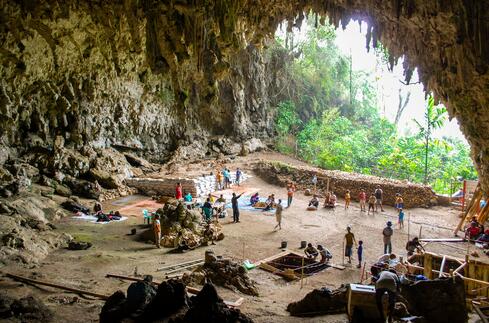Revised Stratigraphy and Chronology for Homo floresiensis at Liang Bua in Indonesia
From:Shanghai Archaeology Forum NetWriter:Date:2017-12-13
The discovery of Homo floresiensis, a human species that went extinct during the Late Pleistocene, from deep within cave sediments on the Indonesian island of Flores sparked intense scientific debates worldwide and attracted a level of public interest rarely seen in any discipline. Announced to the world on October 28, 2004 in the journal Nature, the discovery revealed another human species that also walked on two legs and made and used stone tools; however, adults stood only ~1 m tall and had extremely small, chimpanzee-sized brains (~400 cc), as well as body proportions and other primitive features not seen within the genus Homo for the past ~1.5 million years. The implications of this remarkable discovery continue reverberating to this day. It is clear that human biological and cultural diversity was significantly greater during the Late Pleistocene than it is now when the only humans left are members of a single species, Homo sapiens (modern humans). In other words, our species once shared this planet with Neandertals and Denisovans as well as H. floresiensis. What exactly happened to this particular branch of our human family tree is still poorly understood, but recently published evidence—based on almost ten years of additional archaeological research—shows that H. floresiensis disappears from Liang Bua ~60–50 thousand years (ka) ago, and not 18–12 ka ago, as originally suggested.
Initially dated to ~95–12 ka ago, these ages implied that H. floresiensis survived on Flores long after modern humans had dispersed across Island Southeast Asia and reached Australia by ~50 ka ago. The 30–40 millennia of potential overlap between modern humans and H. floresiensis (and pygmy Stegodon) on Flores was certainly perplexing and challenging to explain relative to the evidence in favor of modern humans in Australia and elsewhere in Island Southeast Asia during the Late Pleistocene, but the earliest evidence for modern humans on Flores was also from Liang Bua and was restricted to the last 11 ka. However, continued excavations and research at Liang Bua have helped clarify this confounding chronological issue.
Based on new stratigraphic and chronological evidence, the skeletal remains of H. floresiensis are now recognized to be between ~100 and 60 ka old, while stone artefacts reasonably attributable to this species range from ~190 to 50 ka old. Stratigraphically, the H. floresiensis-bearing sediments are part of a pedestal of remnant deposits that date to more than ~46 ka. In the areas where H. floresiensis was first discovered, this pedestal has an erosional upper surface that slopes steeply downwards to the north. Unconformably overlying the pedestal are sediments younger than ~20 ka in age and initial misinterpretation of this unconformity led to the errors in inferring the latest occurrences of H. floresiensis. The revised chronology for H. floresiensis evidence includes estimates based on uranium-series dating (234U/230Th) of bones from three individuals. Ulnae belonging to the holotype and two other adults have modelled 234U/230Th ages (± 2σ), which reflect minimum ages of deposition, ranging from 86.9 ± 7.9 to 71.5 ± 4.3 ka (LB1), 71.4 ± 1.1 to 66.7 ± 0.8 ka (LB2), and 66.0 ± 4.3 to 54.6 ± 2.1 ka (LB6). All skeletal and cultural materials thus far attributed to H. floresiensis stratigraphically underlie volcanic tephras (T1 and T3) estimated to be ~60 and 50 ka old, respectively, based on a combination of dating methods that includes infrared stimulated luminescence, thermoluminescence, 234U/230Th, and 40Ar/39Ar. Moreover, credible evidence suggesting that modern humans were on Flores by ~41 ka cal. BP or possibly even as early as ~46 ka cal. BP is emerging from their ongoing research at the site.

As the type site of H. floresiensis, Liang Bua is critical for testing hypotheses about how, when and why this enigmatic species became extinct, but excavation of sediments ~50–20 ka in age has been limited. New excavations were carried out in 2017 over ~12 m2 in the middle rear of the cave to specifically test whether H. floresiensis and associated large endemic fauna survived after ~50 ka. This area of the cave was targeted because our previous test excavations in this area showed that the sediments are between ~50 and 20 ka in age. More than 3,000 findings were recovered in position and more than 47,000 findings were also recovered from sieved sediments. Although these findings require further study, no diagnostic skeletal remains of H. floresiensis, Komodo dragon, giant marabou stork or vulture were found. A single fragment of Stegodon enamel was recovered but this was almost certainly reworked from older deposits. Instead, all of the recovered remains represent smaller animals, mostly rats and bats. This evidence suggests that H. floresiensis and these other large taxa disappeared from the area and were likely extinct (except Komodo dragon) by ~50 ka but further exploration of other sites on Flores is needed. If these taxa did indeed survive elsewhere on Flores after ~50 ka, then they likely never returned to Liang Bua before ultimately going extinct. Instead, the behavioural evidence of hominins we recovered included several more hearth and hearth-like features as well as stone artefacts with roughly equal proportions made of chert and silicified tuff, a pattern seen with modern humans at the site during the Holocene but not in the H. floresiensis-bearing sediments. Together these findings add to the growing corpus of data that suggests modern humans were present at Liang Bua beginning ~46 ka ago, although likely in relatively low population densities until the early Holocene. Whether H. floresiensis survived after 50 ka ago remains an intriguing question that further archaeological research on Flores will hopefully clarify.

